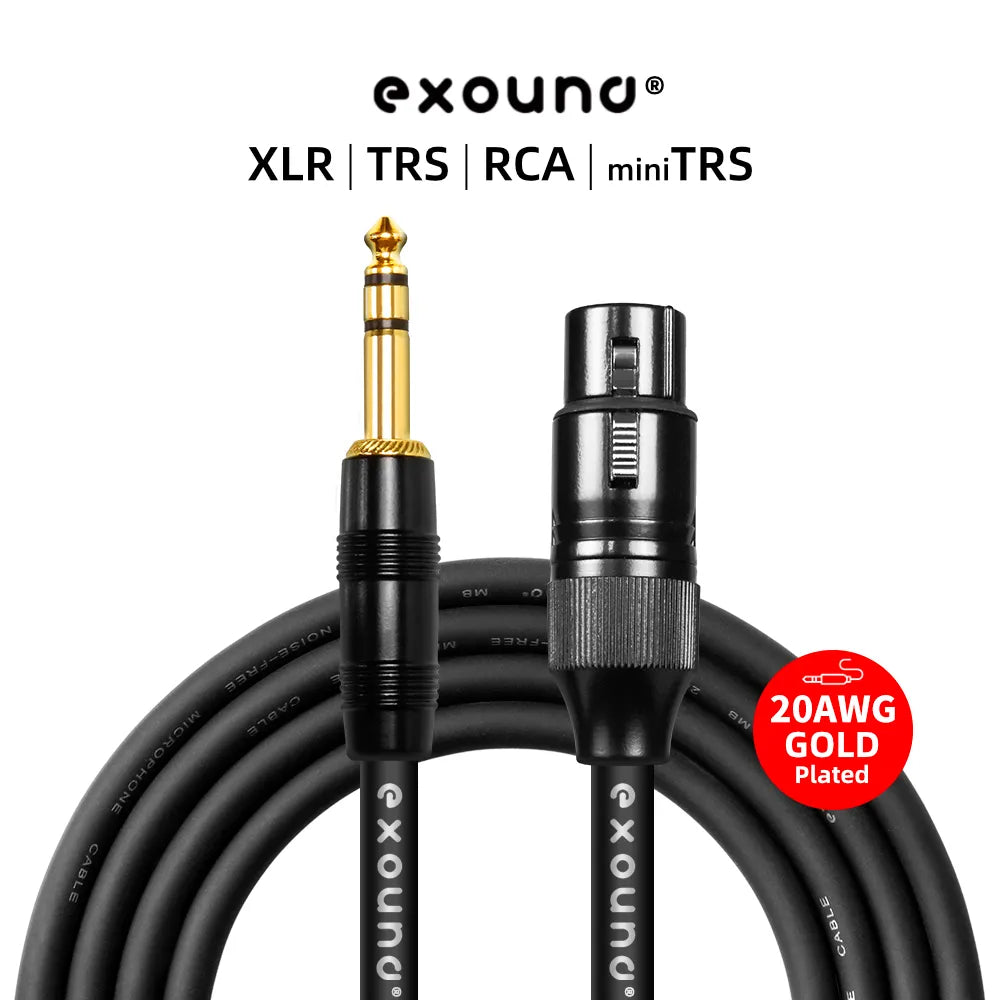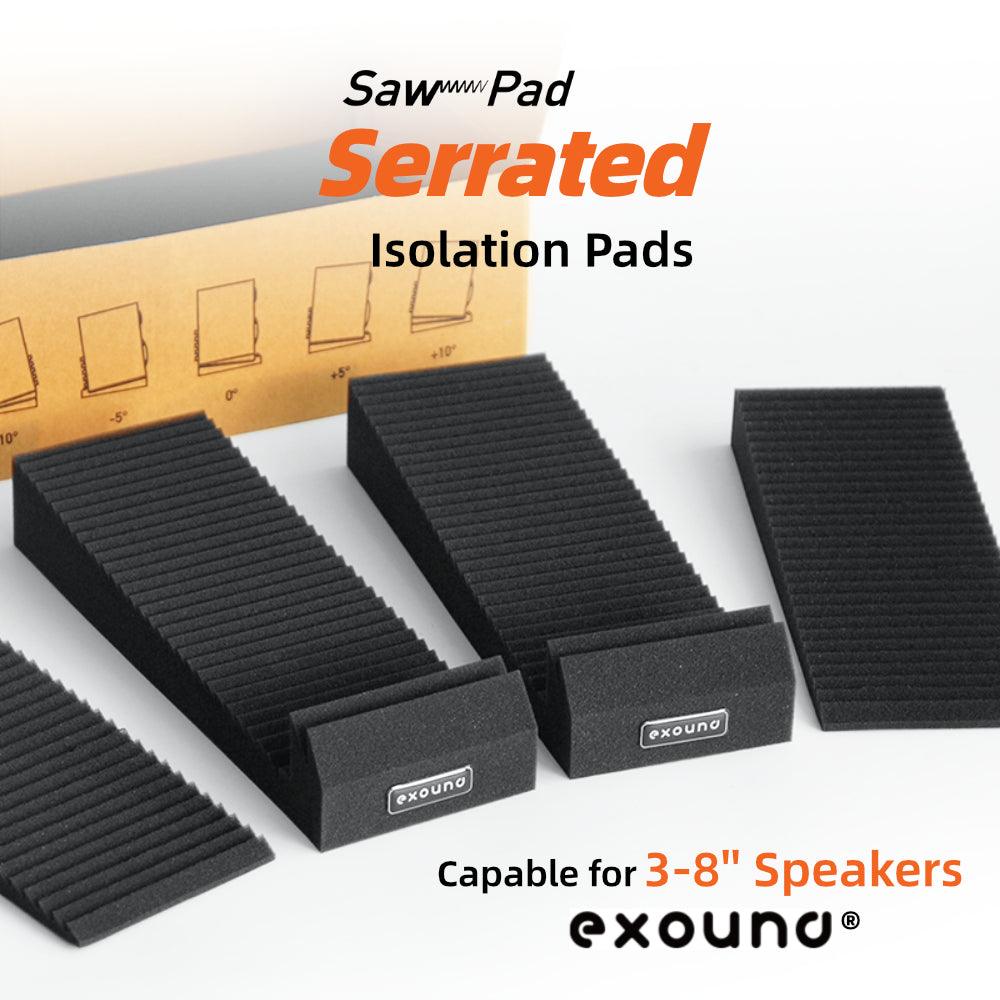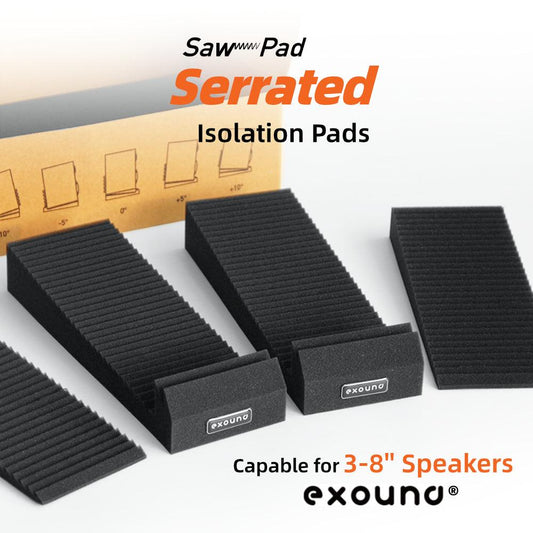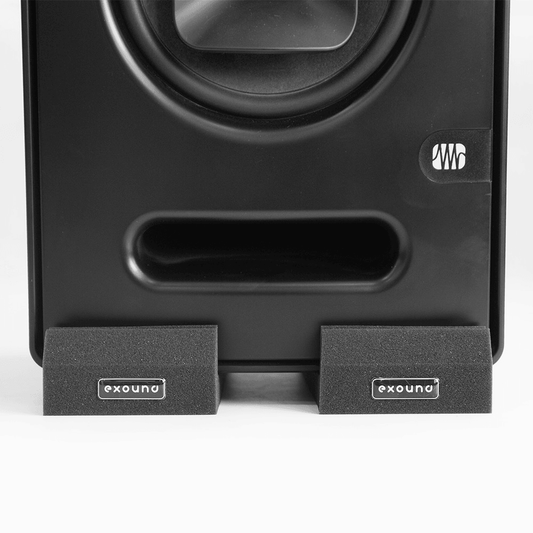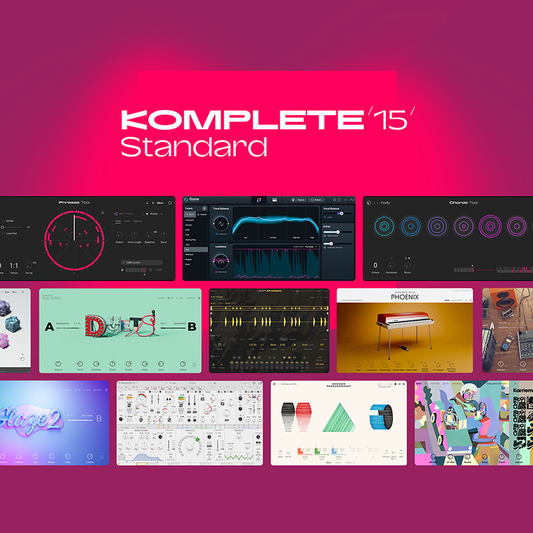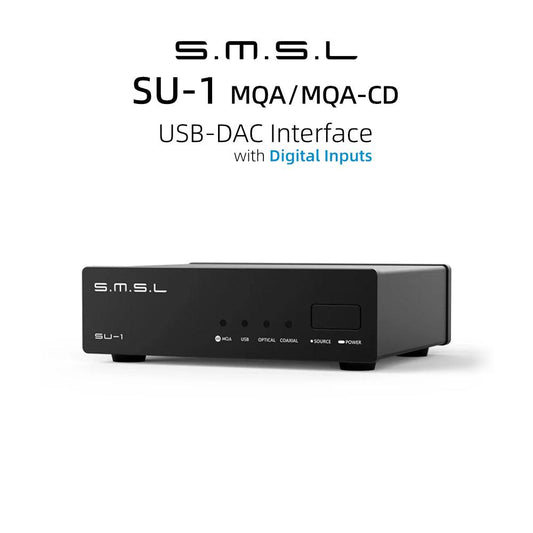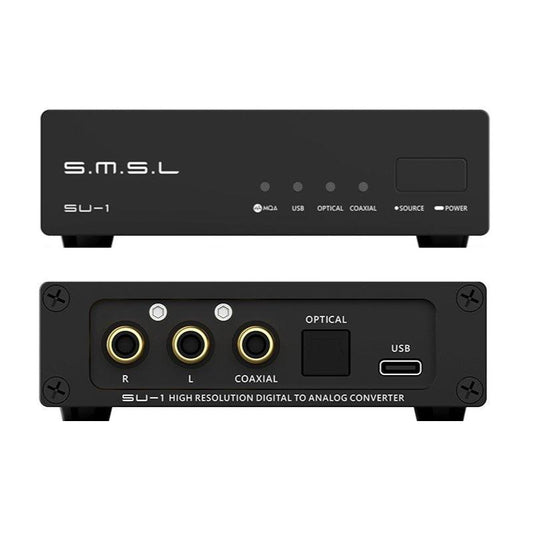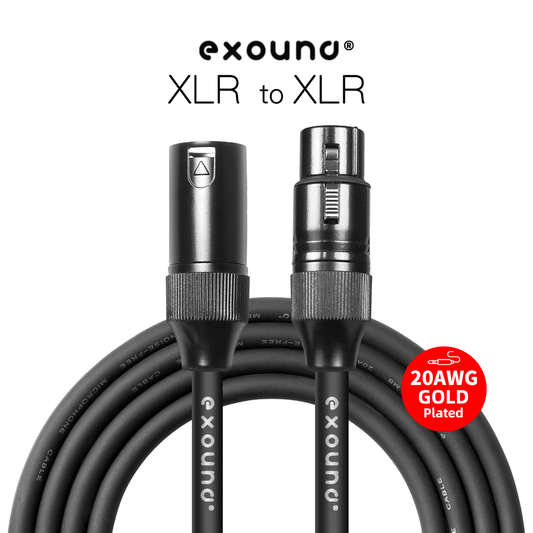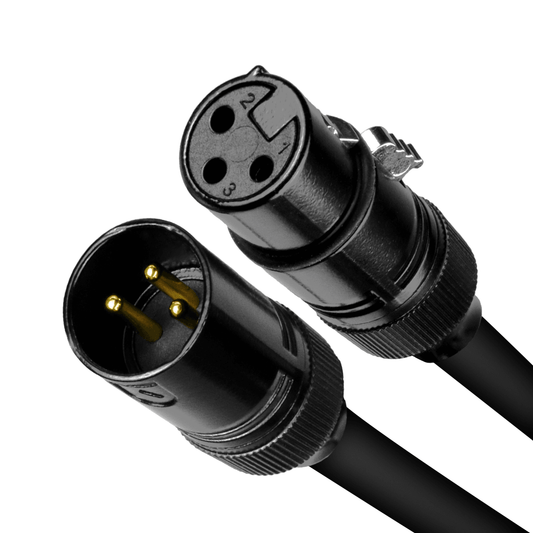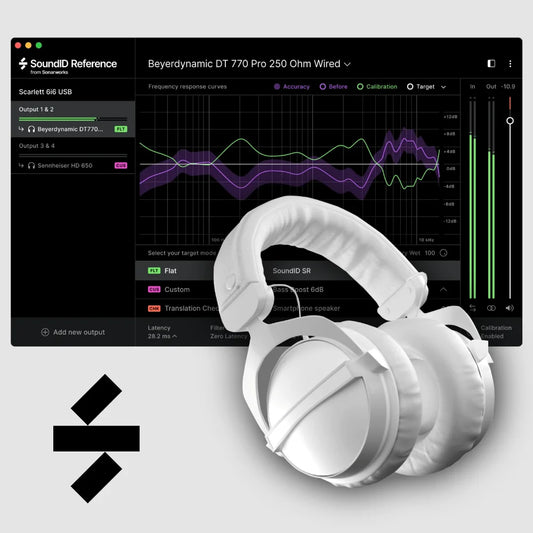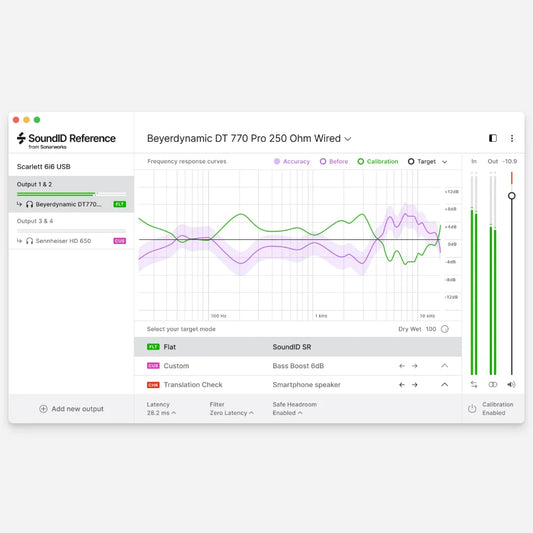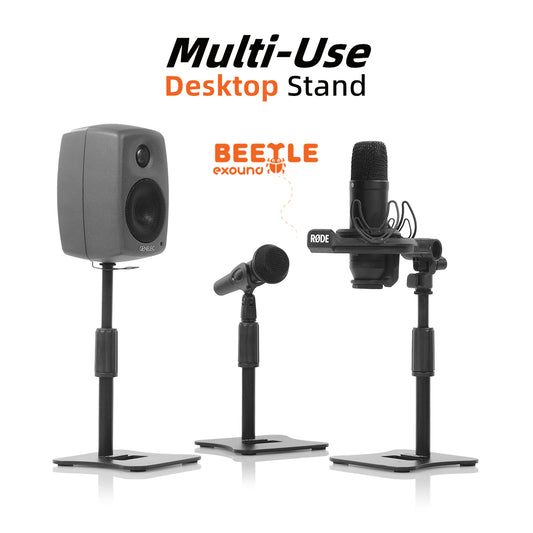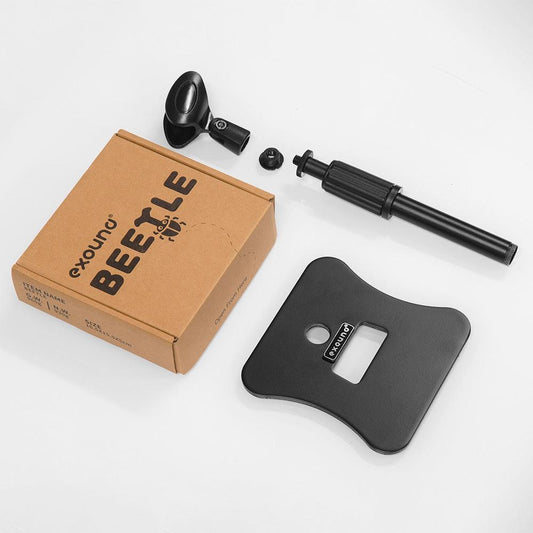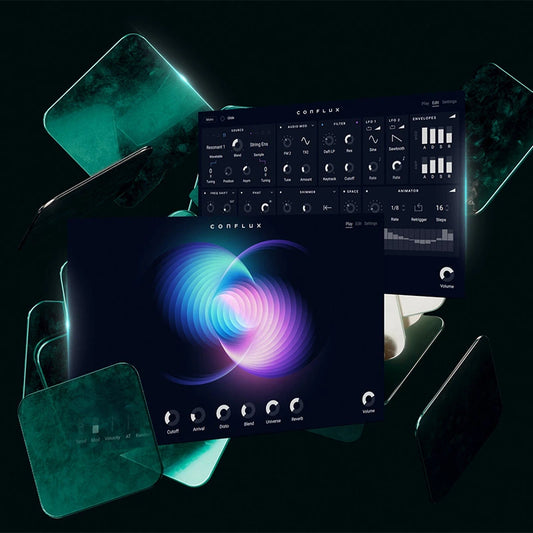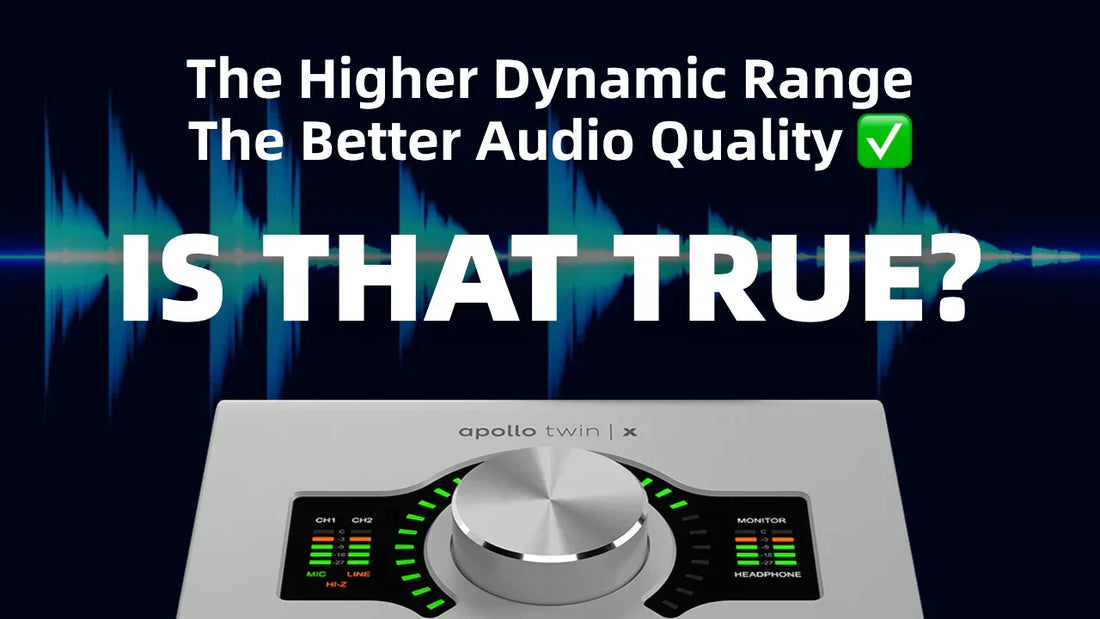
El mito del rango dinámico: ¿Por qué tu interfaz de audio de 130dB no importa?
Compartir este artículo

En el mundo del audio profesional, las especificaciones venden. Entra en cualquier tienda de música o navega en línea, y te verás bombardeado con números impresionantes: rango dinámico de 130dB, 0.0005% de THD+N, y conversión cristalina de 32 bits/192 kHz. Pero aquí hay una pregunta que podría hacerte sentir incómodo:
¿Realmente puedes escuchar la diferencia entre una interfaz de audio con un rango dinámico de 100dB y otra de 125dB cuando se monitorea a través de tus altavoces de estudio?
La respuesta podría sorprenderte, y revela un fascinante recorrido por toda la cadena de audio que la mayoría de los fabricantes preferirían que no entendieras.
La Gran Prueba Ciega de Rango Dinámico

Imagina este escenario: dos interfaces de audio colocadas una al lado de la otra. Una tiene un respetable rango dinámico de salida de 100dB, mientras que la otra afirma tener un impresionante rango dinámico de 125dB. Ambas están conectadas a un conmutador de entrada, y luego se envían a un dispositivo de medición profesional capaz de capturar un rango dinámico de 127dB. La misma pieza musical se reproduce a través de ambos sistemas.
¿Puedes identificar qué interfaz produce la salida 'superior' de 125dB? Si eres honesto contigo mismo, y si eres como la mayoría de los profesionales del audio, probablemente la respuesta sea no. Esto no es un fallo de tu parte; son las leyes de la física.
Dado que las dos interfaces emplean diferentes métodos de control de volumen (analógico/digital), aún queda una diferencia de 0.2dB en el volumen de reproducción incluso después del ajuste. No dejes que la sonoridad te engañe - más volumen no necesariamente significa mayor dinamismo.
Prueba A/B @ 24bit/48kHz (Volviendo Como un Hombre)
Comprender el Rango Dinámico en el Mundo Real
El rango dinámico, fundamentalmente, representa la relación entre los sonidos más fuertes y más silenciosos que un sistema de audio puede reproducir. En el ámbito digital, dado que el volumen máximo está fijado en 0dBFS, un mayor rango dinámico teóricamente significa que puedes escuchar detalles más silenciosos: más información sonora oculta en la mezcla.
Para demostrar este principio de manera más clara, considera estos ejemplos de la misma pieza musical con diferentes rangos dinámicos:
- Rango dinámico de 12dB (fuertemente comprimido)
- Rango dinámico de 24dB (moderadamente comprimido)
- Rango dinámico de 48dB (dinámica natural)
Muestras de Audio de 12dB vs. 24dB vs. 48dB
Las diferencias entre estos ejemplos son inmediatamente evidentes. Entonces, ¿por qué la diferencia de 25dB entre nuestras dos interfaces de audio no es igual de obvia?
El Cuello de Botella Que Nunca Consideraste: Tus Altavoces
Aquí es donde las especificaciones de marketing encuentran la realidad. Los altavoces activos modernos – ya sean monitores de estudio de alta gama o altavoces multimedia – han seguido la tendencia hacia la digitalización. Cuando una señal analógica de tu interfaz de audio entra en estos altavoces, primero debe pasar por una conversión analógica a digital a través del chip A/D interno del altavoz.
Esto crea un cuello de botella inmediato. Considera estos ejemplos del mundo real de monitores de estudio populares:
Especificaciones de Conversión A/D del Altavoz:
- Genelec 8351B: Rango dinámico de 115dB (a entrada de +25dBu)
- Serie S de ADAM Audio: ~120dB de rango dinámico
- Varios monitores convencionales: 100-115dB típicos

Si estás enviando una señal de rango dinámico de 130dB desde tu interfaz de audio profesional a un Genelec 8351B, esa señal debe atravesar el cuello de botella A/D de 115dB del altavoz. Los 15dB adicionales de rango dinámico simplemente se descartan —
estás pagando por un rendimiento que literalmente no puedes escuchar.
El Dilema del Emparejamiento de Voltaje
La situación se vuelve aún más compleja cuando consideramos el emparejamiento de voltaje. El 0dBFS de tu interfaz de audio no existe en el vacío; corresponde a una salida de voltaje analógico específica. Diferentes interfaces producen diferentes niveles de voltaje a volumen máximo:
- Ejemplo de interfaz profesional: +20dBu (aproximadamente 7.75V)
- Ejemplo de interfaz de alta gama: +24dBu (aproximadamente 12.3V)
- Sensibilidad de entrada del altavoz: varía significativamente

Por ejemplo, el Genelec 8351B alcanza su rango dinámico completo de 115dB solo cuando recibe una señal de entrada de +25dBu. Si tu interfaz de audio de 'rango dinámico de 130dB' genera una salida de +20dBu, no solo pierdes 15dB del cuello de botella de conversión A/D, sino también 5dB adicionales debido a una discrepancia en los niveles de voltaje.
Tu rango dinámico efectivo cae a solo 110dB.
La Etapa de Amplificación: Otro Factor Limitante
Incluso si los altavoces usaran una conversión A/D perfecta, la amplificación interna introduce sus propias limitaciones. Los chips de amplificador populares encontrados en monitores profesionales incluyen:
- TPA3220 (preferido por ADAM y EVE): Relación Señal/Ruido de 108dB
- Módulos ICEpower (Serie S de ADAM): ~Relación Señal/Ruido de 110dB
- Amplificadores Hypex (EVE SC4000, Barefoot MicroMain): ~Relación Señal/Ruido de 115dB

Estas relaciones señal-ruido representan máximos teóricos en condiciones ideales. El rendimiento en el mundo real de sistemas de altavoces completos generalmente no alcanza estas cifras.
La Realidad Física: Controladores y Resistencia del Aire
La limitación final —y quizás más significativa— proviene del mundo físico. Los controladores de los altavoces deben superar la resistencia del aire para producir sonido, introduciendo ruido mecánico y distorsión que ninguna cantidad de rango dinámico aguas arriba puede superar.
Solo un fabricante de monitores publica especificaciones completas de SNR del sistema: Monitores JBL Serie 7 especificar:
- SNR del Tweeter: 92dB
- SNR del Woofer: 85dB
Estas cifras representan el rendimiento real y práctico después de considerar todas las conversiones, amplificaciones y limitaciones físicas.

Convirtiendo al Mundo Físico: Verificación de Realidad en dBSPL
Para entender qué significan estos números en la práctica, debemos pasar del mundo teórico de dBFS y dBu al mundo físico de dBSPL (nivel de presión sonora), donde 0dB representa el umbral de audición humana.
Tomando el Genelec 8351B como nuestro ejemplo:
- SPL máximo a largo plazo: 103dBSPL
- Piso de ruido a 1 metro: 5dBSPL
- SNR teórica: 98dB
- SNR práctica a niveles seguros de escucha: Mucho menor
Sin embargo, este cálculo asume que estás cómodo escuchando a 103dBSPL, aproximadamente equivalente a estar a 10 metros de tráfico pesado. A este volumen, el 8351B ya muestra una distorsión de baja frecuencia del 2%, mucho mayor que las cifras de distorsión de 0.000X% que tu interfaz de audio anuncia con orgullo.

El Factor de Salud y Practicidad
De acuerdo con Organización Mundial de la Salud las recomendaciones, los adultos deben limitar su exposición semanal a la presión sonora a 80dBSPL durante 40 horas para prevenir daños auditivos. Esto se traduce en no más de 6 horas diarias de escucha de música a 80dBSPL.
A este nivel seguro de escucha, combinado con pisos de ruido habituales en habitaciones:
- Entorno de estudio de grabación (piso de ruido de 20-25dBSPL): ~55-60dB SNR práctica
- Entorno doméstico (piso de ruido de 30+dBSPL): ~50dB SNR práctica

Cuándo Importa el Alto Rango Dinámico
Esto no significa que las especificaciones de alto rango dinámico sean completamente insignificantes. Se vuelven valiosas en contextos profesionales específicos:
-
Cadenas de señal complejas: Los estudios de grabación rara vez conectan las interfaces de audio directamente a los monitores. Las señales generalmente pasan por paneles de parcheo, controladores de monitores y otros equipos de procesamiento, cada uno introduciendo pequeñas pérdidas.
-
Contenido premezclado: Los estudios de grabación trabajan con material premezclado que suele ser 10dB más silencioso que los lanzamientos comerciales, lo que requiere un margen adicional de rango dinámico.
-
Múltiples etapas de conversión: Algunos flujos de trabajo implican múltiples conversiones A/D y D/A, donde mantener un alto rango dinámico durante todo el proceso previene la degradación acumulativa.

La Sorprendente Verdad sobre las Interfaces Caras
Aquí hay un ejemplo fascinante que ilustra por qué las especificaciones pueden ser engañosas:
- MOTU M2 (interfaz económica): rango dinámico de salida de 120dB a +16dBu
- Lynx Hilo 2 (cuesta 20 veces más): rango dinámico de salida de 127dB a +24dBu
A primera vista, el Lynx parece superior. Pero cuando ambas interfaces generan salida al mismo nivel de +16dBu, el rango dinámico del Hilo 2 disminuye en 8dB a 119dB, siendo en realidad 1dB peor que el económico MOTU M2.
Esto demuestra por qué comprender el panorama completo es más importante que centrarse en especificaciones individuales.

Recomendaciones Prácticas para Profesionales de Audio
Al seleccionar una interfaz de audio, considera estos factores prácticos:
-
Ajusta tu flujo de trabajo real: Si principalmente mezclas a través de monitores activos, un rango dinámico superior a 110-115dB ofrece beneficios mínimos.
-
Considera tu cadena de monitoreo: Toma en cuenta las especificaciones reales de tus altavoces, no solo las capacidades de tu interfaz.
-
Evalúa tu entorno de escucha: La acústica de la sala y el nivel de ruido impactan significativamente tu rango dinámico práctico.
-
Asignación de presupuesto: El dinero gastado en un rango dinámico marginalmente mayor podría invertirse mejor en tratamiento acústico o monitores de mayor calidad.

La conclusión
La búsqueda de especificaciones de rango dinámico cada vez más altas ha creado una desconexión fascinante entre los números de marketing y la realidad audible. Aunque una interfaz de audio con un rango dinámico de 130 dB representa una ingeniería impresionante, sus beneficios prácticos en escenarios típicos de monitoreo suelen ser insignificantes.
Esto no disminuye la importancia de las interfaces de audio de calidad — factores como la calidad del convertidor, el rendimiento de jitter, la estabilidad del controlador y la calidad de construcción siguen siendo cruciales. Sin embargo, esto sugiere que obsesionarse con las especificaciones de rango dinámico más allá de cierto umbral puede ser una energía mal enfocada.
Comprender estas limitaciones no te hace un profesional de audio menos competente; te hace uno más informado.
Las mejores decisiones de audio provienen de entender no solo lo que las especificaciones afirman, sino lo que realmente puedes escuchar en tu entorno de monitoreo específico.
Después de todo, en un mundo donde incluso las interfaces de audio modestas pueden superar las limitaciones prácticas de rango dinámico de la mayoría de los sistemas de monitoreo, quizás sea hora de centrarnos menos en los números y más en lo que realmente importa: cómo suena la música.


